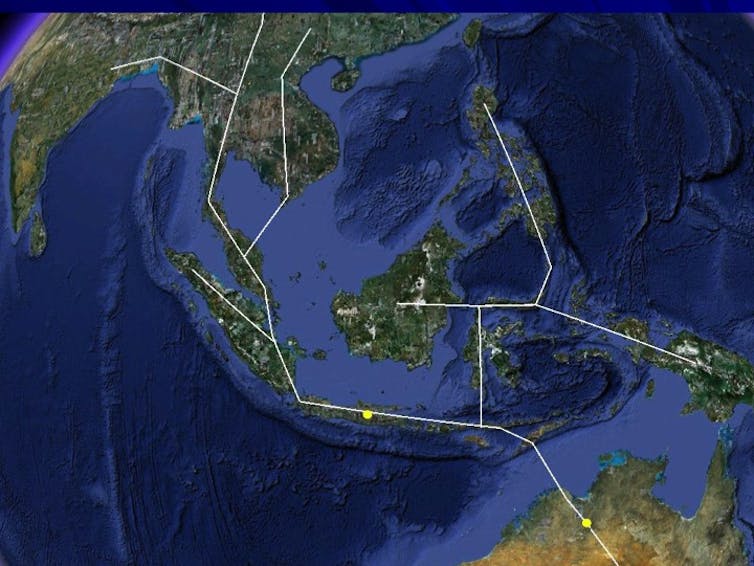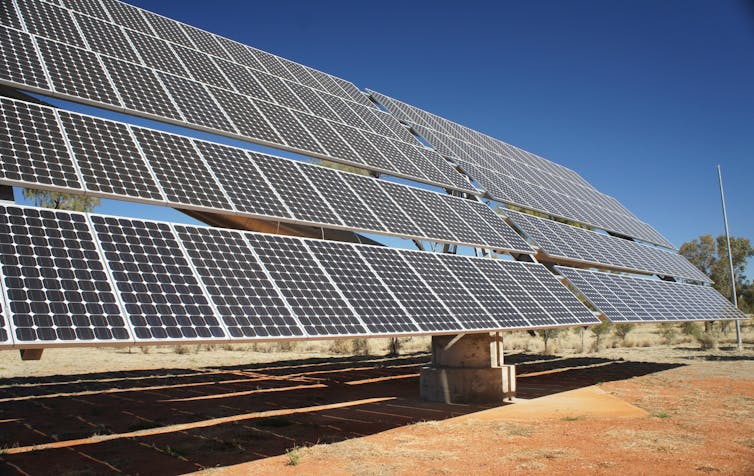It involves dams, but so much more than dams. Image above from Andrew Campbell
Andrew Campbell, Charles Darwin University; Andrew Blakers, Australian National University, and Stuart Blanch, Charles Darwin University
**Northern futures, northern voices: It seems everyone has ideas about how Australia’s north could be better, but most of those ideas come from the south. In this six-part weekly series, developed by the Northern Research Futures Collaborative Research Network and The Conversation, northern researchers lay out their own plans for a feasible, sustainable future.
It may just be election season, but big dreams for the development of northern Australia are back in fashion. So here’s our piece of “next-frontier”, big-picture 21st-century thinking. It may even have room for a dam or two.
A Snowy scheme for the 21st century#
Imagine a project that could help Indonesia achieve energy security, dramatically cut energy poverty for hundreds of millions, catalyse renewable energy production in Assocation of South East Asian Nations (ASEAN) countries, cut regional carbon pollution, and transition Australia’s energy exports from risky fuels to renewable energy.
Sounds far-fetched? In fact, such a proposal has already been published in the international peer-reviewed literature. It takes several existing technologies already in widespread deployment, and joins them together in a new configuration on an unprecedented scale, in a region with enormous natural competitive advantage — north-western Australia.
Here’s the plan.
Take part (say 2,500 km2) of an existing cattle station somewhere near Lake Argyle and cover one third of it with solar panels on tracking arrays. Build a large reservoir upslope at least 300 metres above Lake Argyle, holding at least 1,000 gigalitres of water.
Build a 100 gigawatt power station that uses solar energy to pump water from the lake up to the upper reservoir. The water flows back down the hill through turbines at night, generating power to the grid 24 hours a day, 365 days a year.

Hundreds of “pumped hydro” schemes of this nature are already working well around the world, albeit not on this scale.
The “grid” in this case, would be an integrated south-east Asian supergrid, the spine of which would be a High Voltage Direct Current (HVDC) cable running from northern Australia along the Indonesian archipelago and up into the Philippines, Malaysia and Indochina, and then eventually into China.
The capital cost of building such a power station, storage and HVDC link and extending it as far as Jakarta is estimated at around US$500 billion. This compares with Indonesia’s current projections that it needs to invest US$1,000 billion in conventional (coal and nuclear) power stations to meet its energy needs over the next 40 years.
The electricity price in Jakarta from this scheme would be around 8 cents per kilowatt-hour, compared with the current 6 cents price (externalities excluded) from coal-fired power in Indonesia.
Much cleaner energy, forever, at a comparable price. What’s not to like?
If this sounds unlikely, or too grand by half, let’s back up and look at the individual elements in turn.
Looking back, and looking forward#
The year 2022 will mark 150 years since the first telegraph submarine cable was laid between Darwin and Java, subverting the tyranny of distance by connecting Australia to the rest of the world. It instantly changed our sense of identity, making inter-continental communication possible in hours instead of weeks and months.
For northern Australia, the telegraph line accelerated settlement and growth of the pastoral and mining industries.
Today, northern Australia remains a contested landscape, with some seeing a next frontier for development, and others sounding caution.
Northern Australia should have a much bigger role to play in the rapid growth of its northern neighbours than as a mendicant northern outpost of a big empty continent. The Asian Century White Paper counsels that our future success will be determined by the choices we make today, not on chance.
Almost 150 years after Australia and Asia connected via the telegraph link, it’s time to lay more cables.
The basic idea is to meet the projected almost doubling of energy demand in South East Asia by 2030, by exporting renewable energy from north-western Australia.
For the moment we are focusing on solar energy, because some of the world’s highest solar insolation (the amount of solar energy falling in an area) levels (5-7 kWh/m2/day) are in the region south of Darwin, between Katherine and the Tanami Desert, and the technology is proven and readily available.

In the longer term, geothermal and tidal renewable energy could also feed into this grid.
Several scoping projects have looked at the idea in detail. We recently brought a bunch of energy transmission engineers, consultants, academics and NGOs from Indonesia and Australia to Darwin to map out opportunities and challenges.
The consensus was that this idea is ambitious, but technically feasible and doable. Our Indonesian colleagues had already mapped such a possibility.
There are more than 20 HVDC sub-sea electricity cables around the world today, with many more planned. Renewable energy is exported very profitably and reliably undersea 580km from Norway to The Netherlands and 280km from Tasmania to Victoria.
Iceland plans to wire geothermal power to Scotland, and the Desertec project aims to send solar power 3,000km from Algeria to industrial Germany. Transmission losses in HVDC cables are now down to a few percent per 1000km, more than offset by the 50-100% “solar insolation advantage” of northern Australia over Java, together with the ready availability of land.
The economic equation is moving in the right direction as the price of renewables drops sharply, and as the world starts to put a price on the negative externalities of fossil fuels, including carbon emissions.
Yes it is technically formidable, and assembling the necessary geopolitical and financial architecture to make it happen won’t be trivial.
But the drivers are compelling.
This project would secure sustainable energy and low carbon futures for the fastest growing region on Earth, reducing energy conflicts and energy poverty, tackling climate change and saving rainforests, and exploiting the region’s natural advantage in renewable resources.
This project would catapult us to the forefront of the technology savvy and rapidly growing green energy sector, generating many thousands of high-tech jobs in Australia and beyond.
Such a project would integrate northern Australia into south-east Asia as never before. Indeed it would be transformative for this region, giving real ambition to the idea of “the next frontier”.
This article was co-authored by Rob Law, Policy Officer at Environment Centre NT.![]()
Andrew Campbell, Director, Research Institute for Environment and Livelihoods, Charles Darwin University; Andrew Blakers, Director of the Centre for Sustainable Energy Systems (CSES) , Australian National University, and Stuart Blanch, Adjunct Research Fellow, Charles Darwin University
This article is republished from The Conversation under a Creative Commons license. Read the original article.
